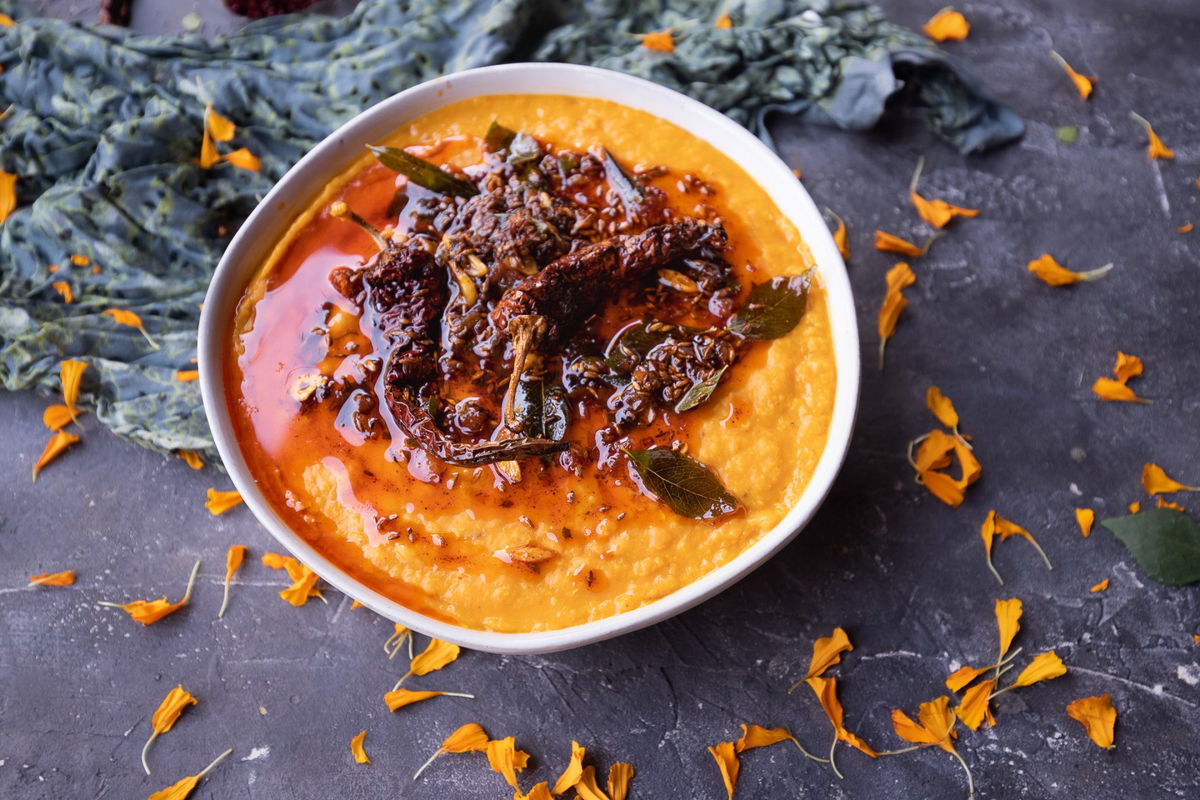Dhokla is a spongy, steamed bread made from rice and lentils. It is vegetarian, even vegan-friendly, rich in protein, and gluten-free because it is made from rice and lentils. Dhokla is essential comfort food for any Gujarati.
About this Recipe
Dhokla is a very old recipe, first mentioned as “Dukkia,” in Jain literature from 1068. The Gujarati Varanaka Samuchaya from 1520 CE recommends making it with a ratio of 2 parts rice to 1 part lentils. This is the same ratio my mom and Grandma used.
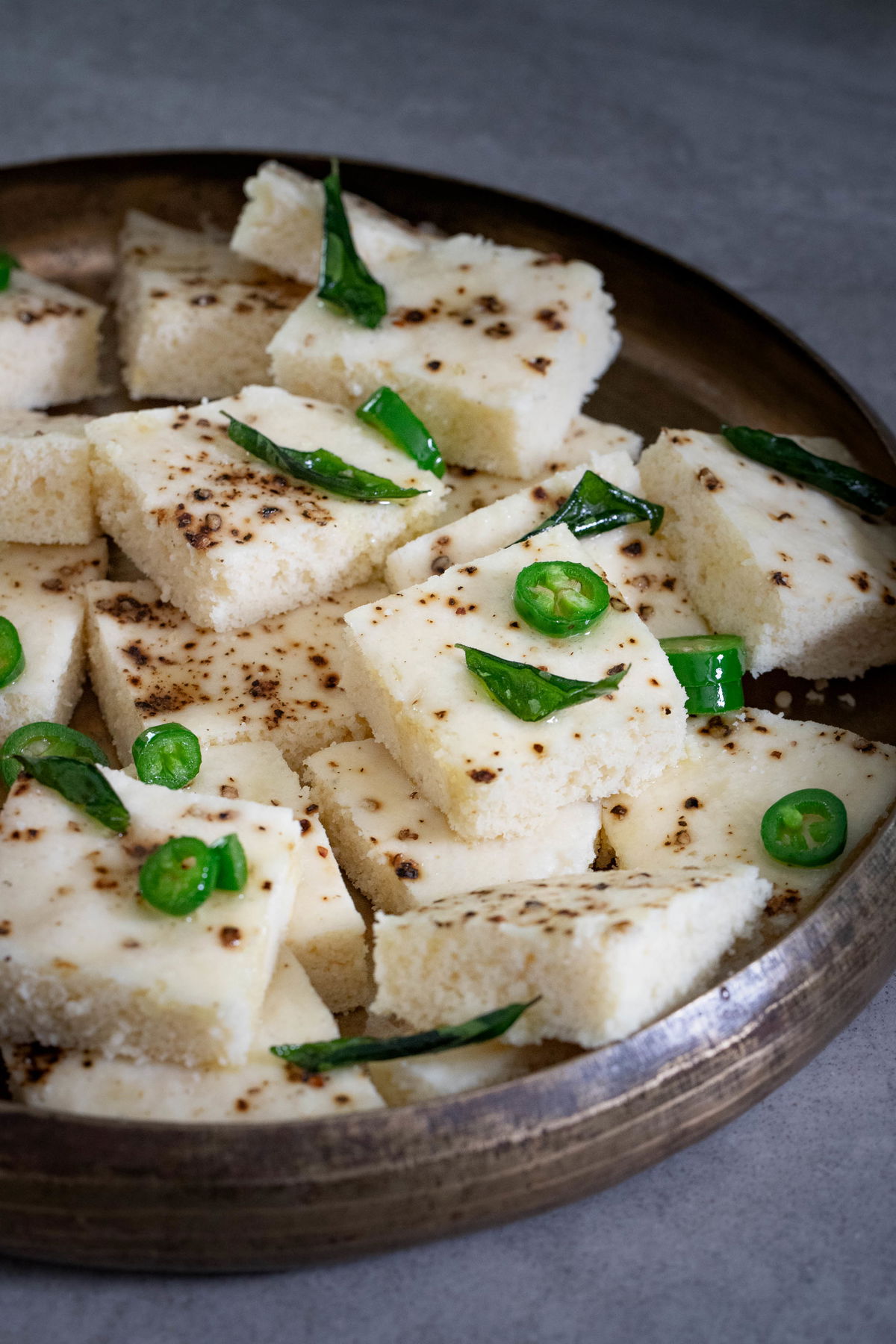
Dhokla is a steamed bread, and steaming is important in Indian cooking. Gujarat has a number of steamed dishes, such as dudhi muthiya, khaman, patra, and more. And dhokla is similar to idli, a well-known South Indian steamed bread made with rice flour and urad dal.
I’ve been making dhokla all my life, but when it came to putting a recipe together for the blog, I remade it about 20 times. I reworked and tweaked it to create a recipe that would be reliable and “just work.”
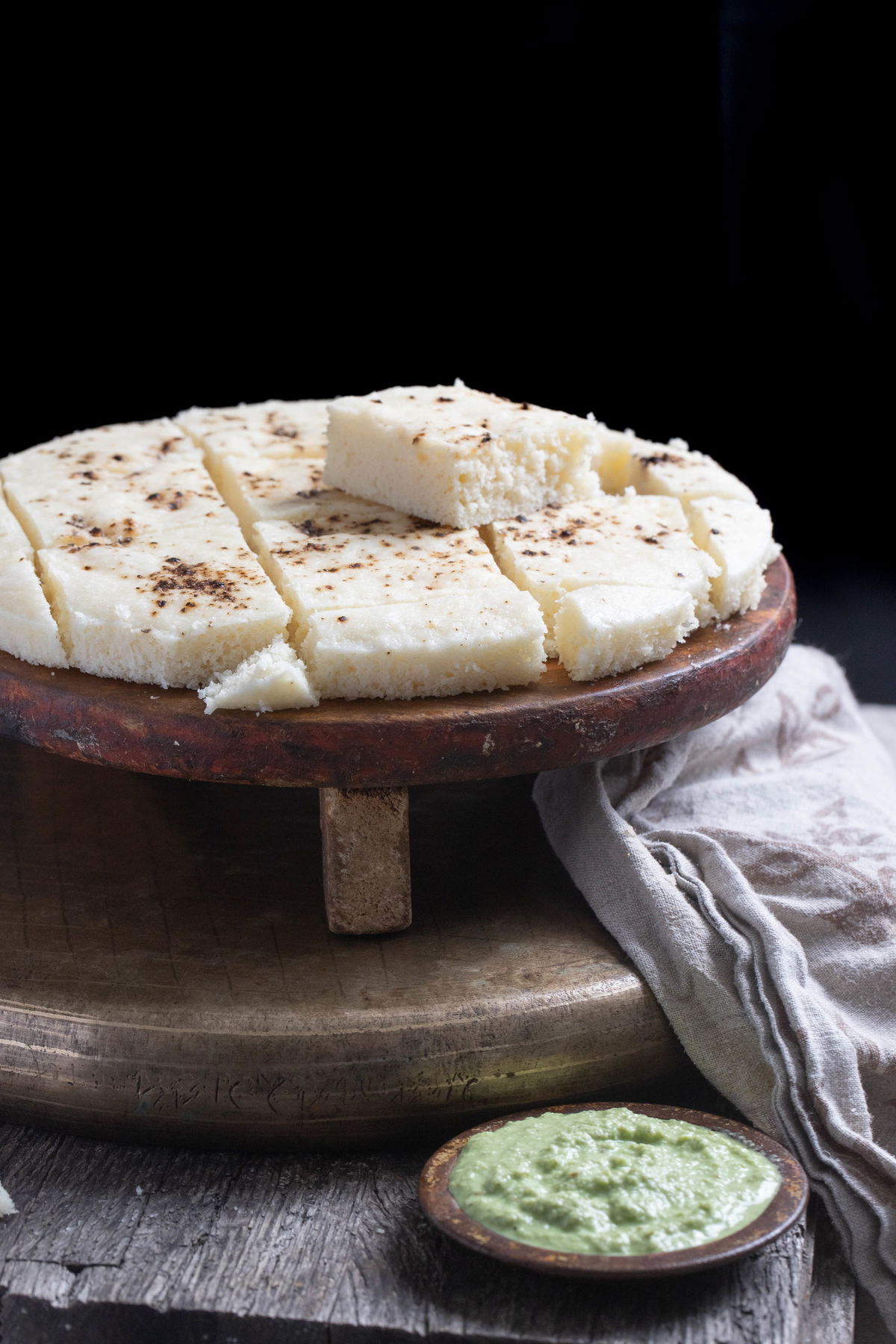
As a Gujarati, getting dhokla right was extremely important to me. It’s not that dhokla is hard to make. It is very easy to make passable dhokla. But many things can go wrong, so it might come out good but not great. After all of this trial and error, I have a lot of tips to provide to achieve great dhokla.
I use a ratio of equal parts rice and lentils. This ratio is more popular today than the traditional ratio. This makes for a more protein than carb-heavy dhokla and has little effect on the taste and texture.
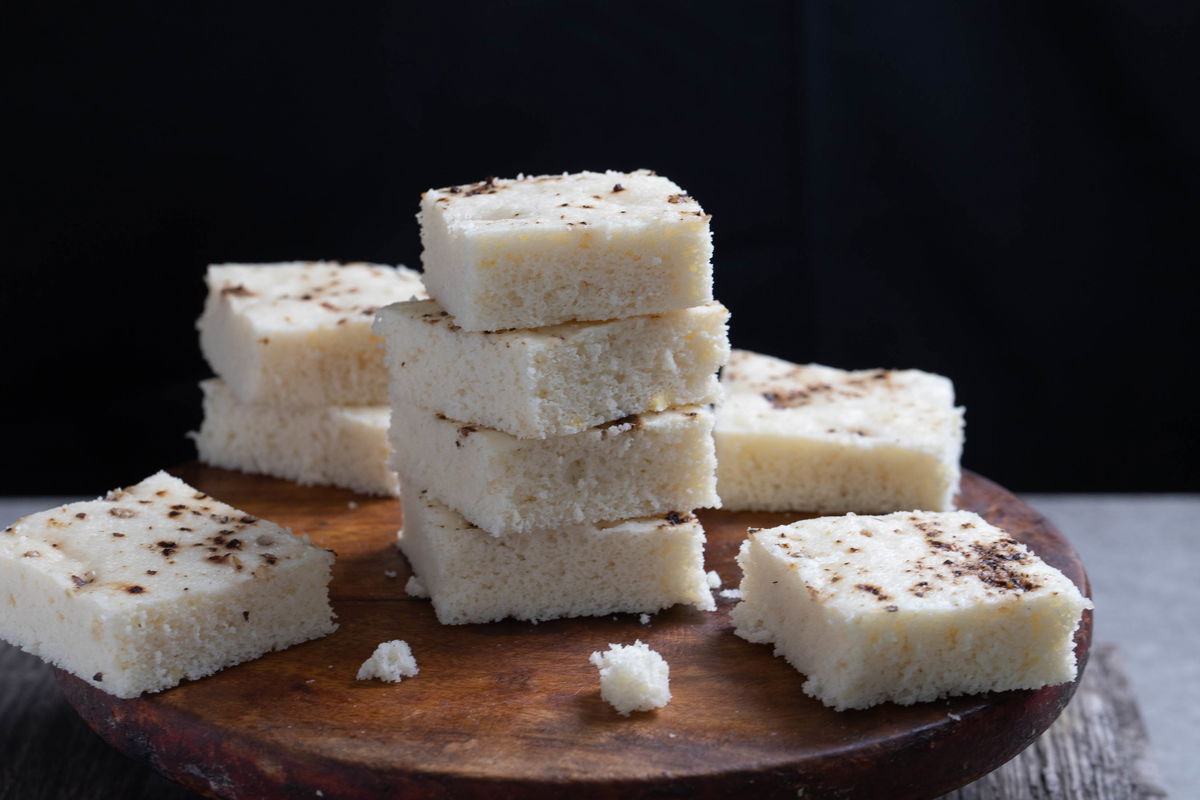
Methods
Traditional dhokla takes about two days to make. That is because the rice and lentils must be soaked for a day, ground, mixed together, and then fermented for another day. Dhokla made in this traditional manner is worth it, but you don’t have to go through all of this effort if you do not have the time. I’ll walk you through the traditional time-consuming method and give you tips on a quicker version that is just as good.

In the old days, they fermented rice and dal to get a spongy texture. Today we use eno or baking powder as a leavening agent. The side-effect of fermentation is a pleasant sourness that gives dhokla one of its other names, “Khatta Dhokla,” meaning “Sour Dhokla.” Whatever you do, do not use baking soda. This will destroy the sourness you spent hours developing.
If you are short on time or do not want to go through this effort, you can make dhokla from dal chokha no lot (handvo flour), and you can choose to ferment it or skip the fermentation and rely on the Eno or baking powder for leavening. I recommend using Eno or baking powder even if you do ferment your batter. It will help get the texture just right.
I provide instructions for each of these methods.
Ingredients
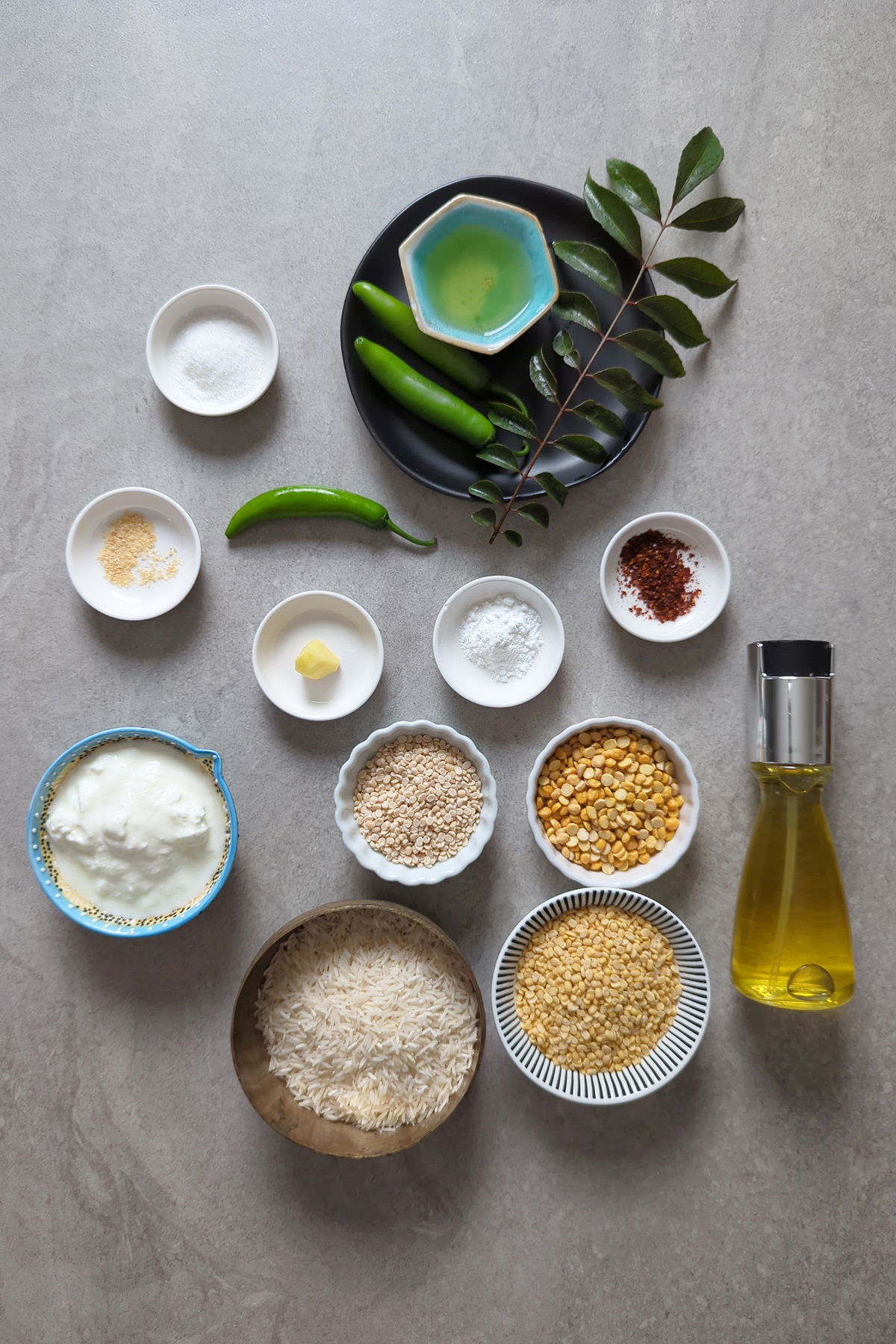
Rice – I use basmati rice, but traditionally a short-grained rice would be used. Indian short-grained rice is more difficult to get in the US. Calrose or unaged basmati rice will offer a higher starch content closer to the traditional recipes.
Dal – I use a mix of chana, moong, and urad. Some people will use tuvar in place of moong. Many people use only urad dal for khatta dhokla, but my mom has always used this mix of dals and it is delicious. But as long as you have the same quantity of dal as the rice, you can use any lentils you like. Experiment to find the flavors that work for you..
Yogurt – starts the fermentation and helps add the sour flavor.
Ginger-Chili Paste – a classic Gujarati paste and flavor combination.
Asafoetida – This ingredient is optional. Adding it adds a subtle onion-like flavor. Note that traditional asafoetida or hing is not gluten-free (some wheat is mixed in to add bulk). So remember to buy a gluten-free hing if you are avoiding gluten.
Salt
Black pepper or red chili powder – black pepper is the traditional spice, with red pepper becoming a common substitution in modern cooking. Both taste great, but I am partial to the black pepper.
Vaghar – in my family, we stick to the simple vaghar of oil, curry leaves, and fresh chilies. Many people will add sesame seeds or mustard seeds.
Eno or Baking Powder – Eno is sold as a stomach soother but is essentially baking powder with citric acid or Alka-Seltzer without the aspirin. Eno has become an essential leavening agent in Gujarati cooking over the last century, saving lots of time over fermentation. After lots of experimentation, I can say that the substitution ratio for these is 1 part eno to 2 parts baking powder.
Soaking the Rice and Dal vs. Using Dal Chokha no Lot
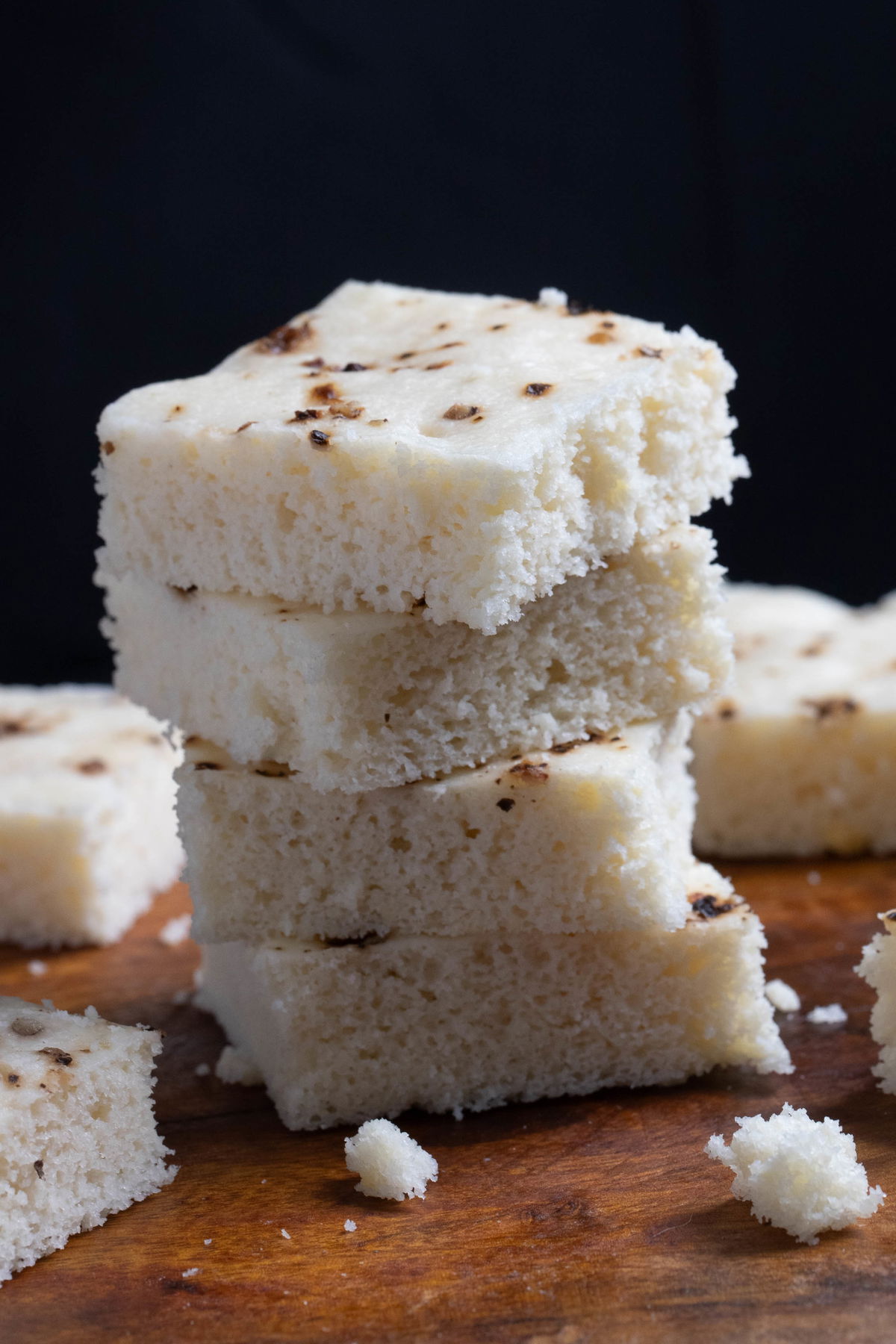
The soaked and ground rice and dal will give you a smoother textured, softer dhokla. So if you’re looking for that super soft and spongy dhokla, you must soak the ingredients and then grind them separately.
But if you’re prioritizing dhokla flavor and don’t mind a bit of coarser, khaman-like texture, save yourself a few hours and use dal chokha no lot.
Equipment
To make dhokla you need a steam pot and trays that will hold your batter and fit in your steam pot. You can hack this together from equipment in a typical kitchen, by using a stock pot,a cake tin that will fit inside, a trivet or even a ball of foil to raise the pan above the water, and a large lid. However, if you plan to make dhokla often, some equipment is worth the investment. Here is what I like to use:
Instant Pot – you can use your Instant Pot as a steamer, either in steam or sauté mode (I prefer sauté). Alternatively, you can use an electric steamer or stovetop steamer pot. Be sure to wrap the lid in a towel to keep condensation from dripping down over the dhokla as it cooks.
Dhokla Trays – These are steel trays with ridges ideal for dhokla. The ones I use are built specifically for the Instant Pot, so they fit nicely, and they have a convenient rack. Before I had the rack, I had a couple of trays that also worked but had to be made one at a time. Now I can make up to three trays worth at once. These trays also fit my old pressure cooker, and I have used them on the stovetop.
Slow Cooker Lid – using a special lid for this is not necessary, any lid large enough to completely cover the pot, wrapped in a towel, works well. The slow cooker lid is a nice convenience if you already own it because it is simpler and lighter.
Offset Spatula – an offset spatula is the ideal tool for lifting the dhokla out of the pan. It has changed my dhokla making life! You can use a regular spatula or a fork if you don’t have one, but you might crumble a piece or two in the process.
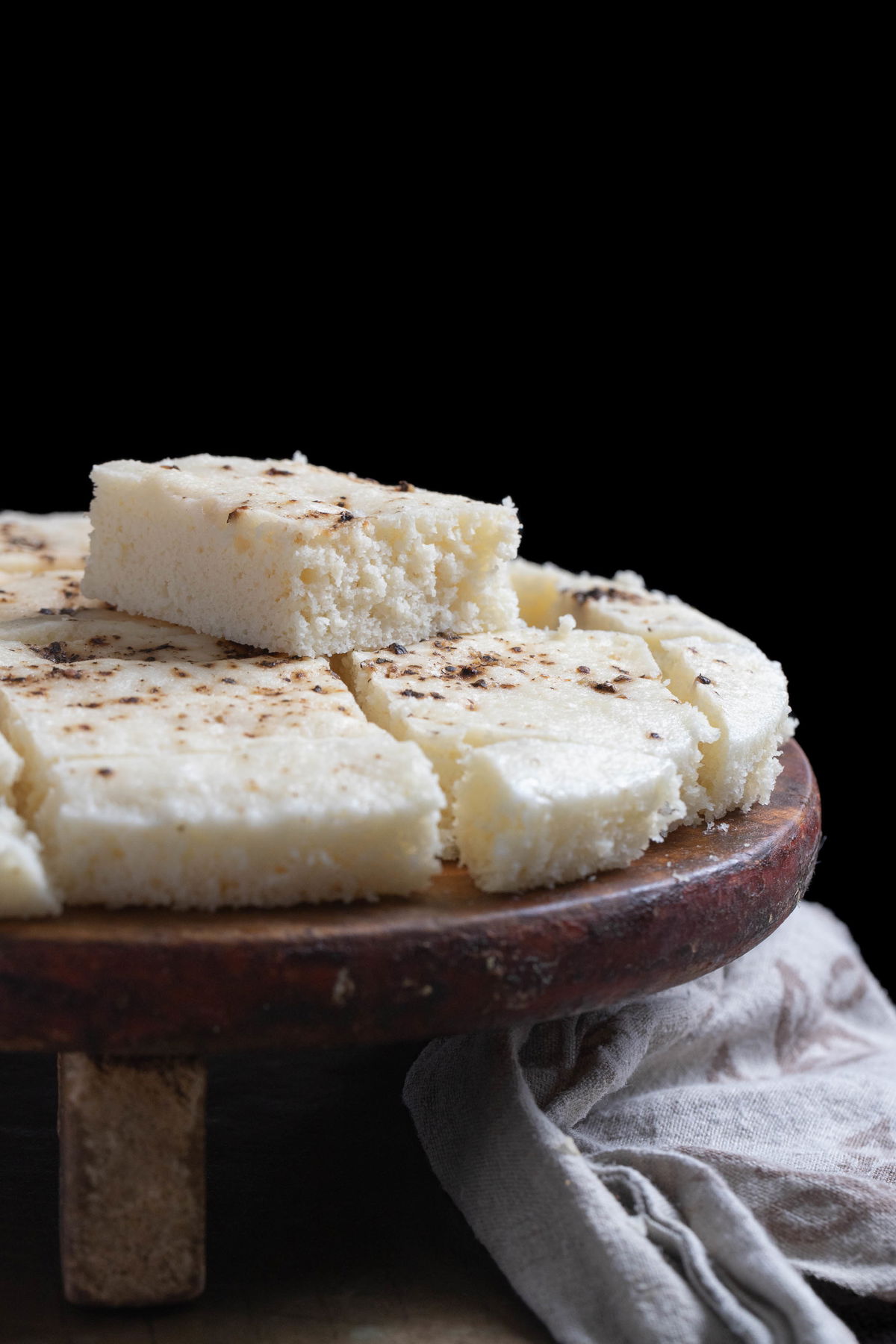
Cooking Tips
- Wrap the steamer lid in a towel. This is something I have always done, and my mom taught me to do this long ago. But when I started using the Instant Pot to steam, I experimented with not wrapping the lid. As I had feared, some water condenses and drips back onto the dhokla. It doesn’t make the dhokla soggy, but it does affect the texture, interfering with the rise.
- Eno versus Baking Powder – Recipes for dhokla generally call for Eno fruit salt to help give the steamed bread its soft, spongy rise. Eno and baking powder are both calcium bicarbonate mixed with a dry acid and can be used interchangeably. However, Eno is a little more powerful, so you will have to double the baking powder. Do not use baking soda. Many people recommend baking soda in place of Eno, but this is wrong. Baking soda is pure calcium bicarbonate. It reacts with the acid created during fermentation and neutralizes it, destroying the wonderful tart flavor that you spent so much time developing.
- It is important to grind the rice only for a short time (20 to 40 seconds) as keeping the rice grainy is important to make sure that the dhokla texture doesn’t become slimy. I tested grinding the rice and dal together, and the results were acceptable (not great), but when I ground the rice too finely, the final dhokla had an unpleasant doughy texture.
- If making Dhokla one tray at a time, separate the batter into equal parts based on the number of trays
Serving Dhokla
Dhokla is a traditional Gujarati snack food. Gujarat has a tradition of eating snack foods throughout the day in such a way that they might replace meals. For that reason, dhokla is often eaten as a breakfast food, as an accompaniment to cha, or it can often be featured in a thali alongside rice, dal, and shaak.
Dhokla should be served with a green chutney, such as this simple green chutney for chaat.
Refrigerating Dhokla
Dhokla should be kept in the refrigerator for up to 5 days since it is made with rice and dal. You can eat it cold or pop it in the microwave for a few seconds to take the chill off. The best way to reheat dhokla is to wrap a few pieces in a damp towel and microwave it for 20 seconds (longer if heating more than a few squares).
Dhokla can also be frozen for up to 3 months and reheated similarly.
Khatta Dhokla, White Dhokla
Dhokla is a spongy, steamed bread made from rice and lentils. It is vegetarian, even vegan-friendly, rich in protein, and gluten-free because it is made from rice and lentils. Dhokla is essential comfort food for any Gujarati.
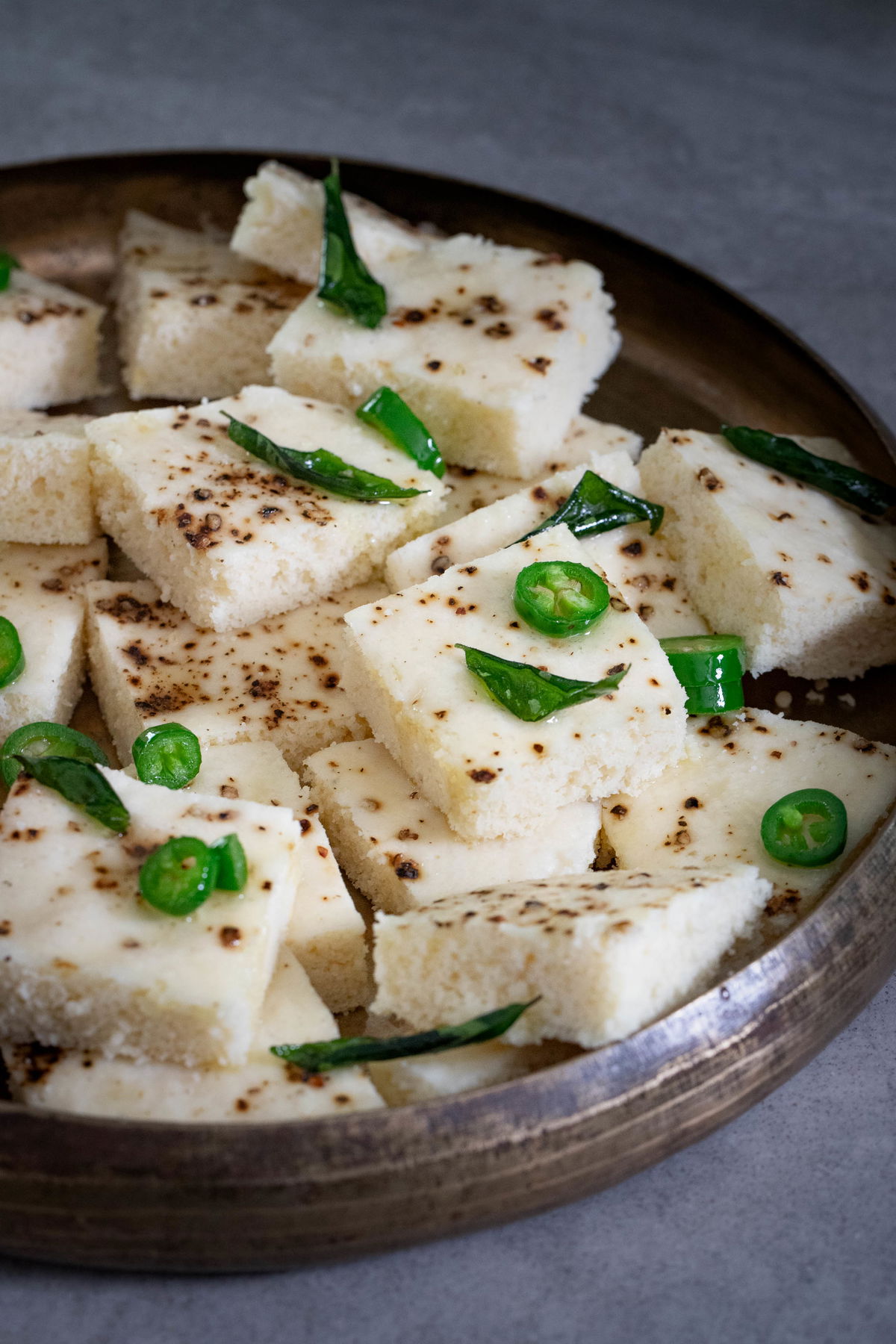
Ingredients
For Rice and Dal Method
- 3/4 cup rice (cal rose or Basmati rice work well)
- 6 Tbsp moong dal
- 3 Tbsp chana dal
- 3 Tbsp urad dal
For Choka no Lot (Handvo Flour) Method
- 1 1/2 cups Handvo flour (choka no lot)
- 1/2 cup plain yogurt of choice (plant based yogurts will work just fine)
- 1 cup water
- 1/2 inch piece of ginger (peeled and cut into small chunks)
- 1 tsp sea salt (or to taste)
- 1 green chili (like Serrano or Thai chili)
- 1 pinch of hing/asafeotida (optional)
- 2 tsp baking powder or 1 tsp Eno fruit salt
- 1/2 tsp coarsely ground black pepper
- Oil to grease the trays (spray oil works well)
For the Vaghar (optional)
- 2 Tbsp oil (neutral high smoke point oil like avocado)
- 1 green chilies (cut into slices)
- 10 curry leaves or handful of cilantro leaves (coarsely chopped)
- Pinch salt
Instructions
Make the batter with Lentils and Rice
- Rinse the rice 3 times. Add 3 cups of water and let soak for 4 hours or up to overnight
- In a separate bowl, combine all the lentils and rinse 3 times. Add 3 cups of water and soak separately from the rice for 4 hours or up to overnight
- Drain the rice and transfer to a blender with the yogurt and a splash of water. Blend for 20 to 40 seconds (or a bit longer if using a lower powered blender), until the rice is broken down into small grains (corn meal texture). Transfer the rice to a large bowl.
- Now add the drained lentils to the blender (no need to rinse it first). Add the ginger, green chili, salt, asafoetida, and remaining water. Blend for 1 to 2 minutes until the lentils form a smooth paste. Transfer the lentil mixture to the bowl with the rice and mix well.
Batter with Dhokla with Dal Choka no Lot (Handvo Flour)
- Use 1.5 cups handvo flour in place of the rice and lentils.
- Blend the ginger, green chili, yogurt, salt and hing in a small blender
- Combine the handvo flour with 1.5 cups water and the yogurt mixture. Let fermet for 4 hours or up to overnight. If short on time, you can skip the fermentation step. Simply allow the handvo flour mixture sit for 30 to 60 minutes so that the flour can absorb the liquid and then add 2 tsp of lemon juice to mimic the acidic flavor of the fermentation.
Ferment the Batter
- Cover the mixture and set in a warm spot. Let the mixture ferment for 6 hours to overnight. If you’re running low on time, you can skip this step and add 2 tsp of lemon juice instead to replace the sourness achieved by fermentation.
Steam the Dhokla
- Add 2 cups of water to the Instant Pot and turn on Saute Mode and allow the water to come to a boil.
- While the water comes to a boil, grease the dhokla trays and cover the Instant Pot slow cooker lid with a large kitchen towel. Tuck the edges into the handle.
- Add the baking powder or eno to the dhokla batter and mix well. The batter will begin to bubble up. Be sure to mix the bubbles well so they are distributed evenly.
- Equally distribute the batter into the greased trays and sprinkle with black pepper.
- Set the trays into the steamer, ensuring that the trays are not submersed in the water.
- Place lid and let steam for 15 minutes.
- Remove from the steamer and let cool for 10 minutes.
- Score along the edges using a sharp pairing knife. Then cut the dhokla into squares. Lift the squares out of the trays using an off-set spatula.
- Serve warm with some chutney or add the optional vaghar
For the Vaghar (optional)
- Heat the oil in a small pan
- When hot, add the curry leaves, let them sizzle
- Add the green chilies and cook for a few seconds until they begin to soften.
- Add an optional pinch of salt to soften the chilies more and add a burst of flavor
- If using cilantro instead of curry leaves, add the chilies to the hot oil first. Add cilantro and immediately take off the heat.
- Pour the vaghar over the dholka squares.
Notes:
These cook times have been tested with the batter divided between 3 8-inch trays as well as 2 10-inch trays, and it works for both. If you use a different size pan, the dhokra may be thicker or thinner, which will affect the steaming time. You can tell that dhokra is done if the top is firmly set but still moist.
Video
Vagharela Dhokla
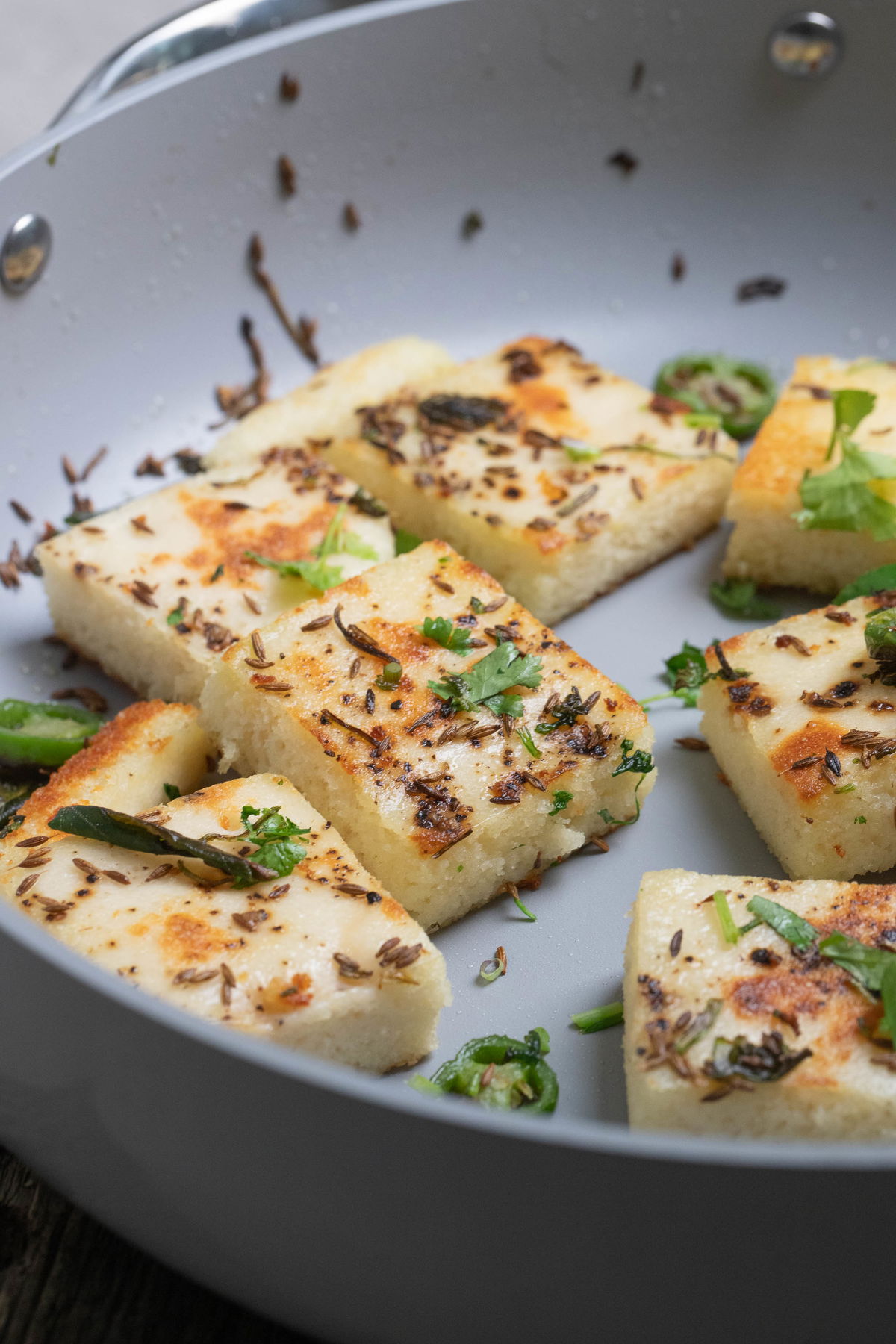
If you have leftover dhokla, try vagharela dhokla. Vaghareladhokla is a way to pan-fry dhokla and add additional flavor. It has a nice crunchiness and is so flavorful. These are my favorite, and I always save some to fry up later.
For Vagherela Dhokla (the best version there is and excellent for leftover dhokla)
1 Tbsp oil
1 green chili, sliced
1 tsp cumin seeds
1 Tbsp of water (if using leftover dhokla that is refrigerated or frozen, not needed for fresh dhokla)
Heat the oil in a large flat-bottomed pan. When the oil is hot, add cumin seeds and let sizzle for a few seconds. Add the green chili and then the dholka.
Let the dholka cook until crisped on all sides.
Serve warm with chutney.
